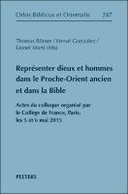Explore

Représenter dieux et hommes dans le Proche-Orient ancien et dans la Bible
0 Ungluers have
Faved this Work
Login to Fave
What was the function of representing deities and also humans in the ancient Near-East? Which were the different ways of making gods visible, and the specific functions of these representations? Might these material and visual representations help us to better understand official cults, as well as private cults? What was the role of images in the royal cult? Was the king the only “image” of the gods, or could all humans fulfill this role? Why were cult images forbidden? Does the biblical prohibition have any precedent or parallel in the ancient Near-East, or elsewhere? And how do the ways of representing gods and humans change in the absence of cultic images? The conference Representing Gods and Humans in the Ancient Near-East and in the Bible, held at the Collège de France, Paris, on May 5-6 2015, sought to shed light on these questions surrounding the image, a critical issue for our understanding of ancient as well as modern religions.
This book is included in DOAB.
Why read this book? Have your say.
You must be logged in to comment.
Rights Information
Are you the author or publisher of this work? If so, you can claim it as yours by registering as an Unglue.it rights holder.Downloads
This work has been downloaded 93 times via unglue.it ebook links.
- 93 - pdf (CC BY-NC-ND) at OAPEN Library.
Keywords
- Ancient history: to c 500 CE
- Ancient Near East
- Bible
- cult images
- History
- History: earliest times to present day
- Humanities
- thema EDItEUR::N History and Archaeology::NH History::NHC Ancient history
Editions

